
Future of Cryptocurrency - Is Crypto the Future?
%201.svg)
%201.svg)


If you are wondering about the future of cryptocurrency, we did some digging to answer that, and more.
Cryptocurrency has gained popularity and value in recent years, with the most well-known cryptocurrency, Bitcoin, reaching an all-time high in late 2021. However, the future of the crypto market is uncertain and the subject of much debate. Some analysts predict continued growth, while others foresee a potential crash. In this article, we will explore the potential future of cryptocurrency, including potential growth, crashes, and the role of regulation. We will also discuss predictions for specific cryptocurrencies, such as Bitcoin and Ether, as well as altcoins and decentralized finance (DeFi) and autonomous organizations (DAOs).
Will cryptocurrencies take off? Understanding the potential future of the crypto market can help investors make informed decisions about their investments.
11 Significant Crypto Predictions for 2023
By examining the past trends and indications in the crypto market, it appears that the future of crypto holds exciting opportunities for investors. Here are some notable crypto predictions to keep an eye on in 2023:
Continued Popularity and Growth
Some analysts predict that the popularity and value of cryptocurrencies, particularly Bitcoin, will continue to rise in 2023. This could be due to increased acceptance by businesses and higher demand for Bitcoin exchange-traded funds (ETFs).
Steep Crash
However, others believe that the crypto market is unstable and vulnerable to a crash. In 2022, Bitcoin's price fell by roughly 40% due to factors such as slowing economic growth and rising interest rates. This bearish market may continue into 2023, leading to a potential crash.
Volatility and Regulation
Regardless of whether the market experiences growth or a crash, it is likely that Bitcoin and other cryptocurrencies will continue to be volatile. This volatility could be mitigated by increased regulation of the crypto market, which some predict will play a more significant role in 2023.
DeFi and DAOs
The shift toward decentralized finance (DeFi) and autonomous organizations (DAOs) is expected to continue in 2023. DeFi aims to remove the need for middlemen in traditional financial products, while DAOs are a new type of internet community based on blockchain technology. These developments could help to increase the stability and growth of the crypto market.
Bitcoin's Price
Some analysts predict that Bitcoin's price will continue to rise, potentially reaching $100,000 by the end of the year. Others believe that the market is unstable and could experience a crash.
Increased Adoption
It is predicted that over 500 million people worldwide will invest in and own Bitcoin by the end of 2023. This could be due to increased awareness and acceptance of the cryptocurrency.
ETF Approval
The approval of the first spot Bitcoin ETF in the US is possible in 2023. This would allow investors to have direct exposure to the cryptocurrency itself, rather than just tracking Bitcoin futures contracts.
DeFi and DAOs
The shift toward DeFi and DAOs is expected to continue and could become the highest growth areas of the crypto market.
Ether's Performance
Some analysts predict that Ether, the second-largest cryptocurrency by market value, will outperform Bitcoin again in 2023.
Regulation
It is possible that regulation of the crypto market will play a more significant role in 2023, potentially helping to stabilize the market.
Altcoins
The performance of altcoins, or alternative cryptocurrencies, is uncertain. Some may experience growth, while others could struggle. It is important for investors to carefully research and evaluate individual altcoins before making any investments.
Key Takeaways
When we see crypto from the growth perspective, there is a fair chance of getting the climb in 2023, especially for Bitcoin. However, Ether can take over the throne owing to the stats of 2022.
If you are seeking expert research and analysis to inform your investment decisions, consider signing up for Token Metrics. Our platform can provide you with access to the best performing cryptocurrencies with just a click. Explore our plans to learn more.
AI Agents in Minutes, Not Months


.svg)



Create Your Free Token Metrics Account





.png)
Recent Posts
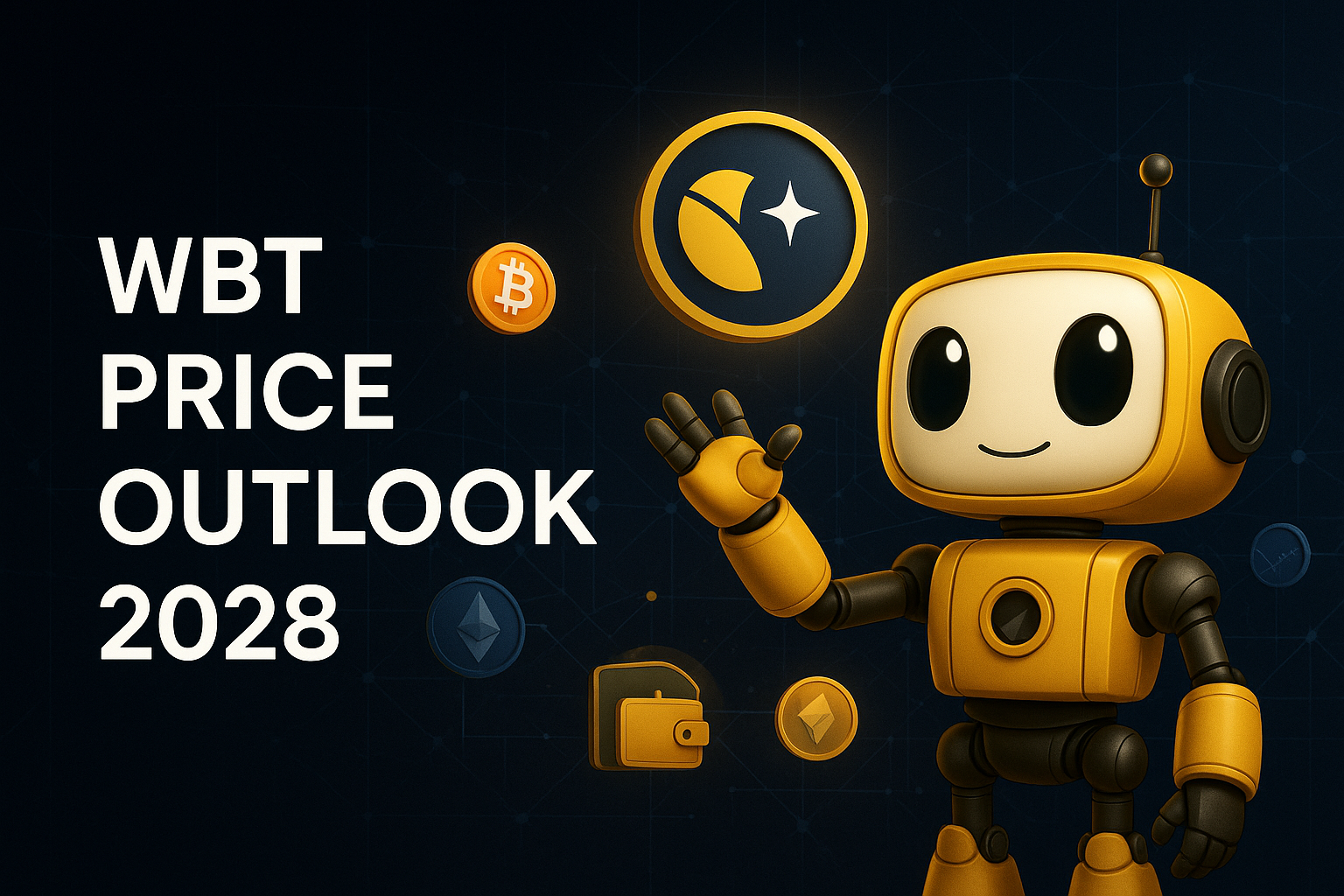
WhiteBIT Coin Price Prediction 2028: $40-$272 Target Analysis
%201.svg)
%201.svg)
WhiteBIT Coin Price Prediction: Portfolio Context for WBT in the 2028 Landscape
Exchange tokens like WhiteBIT Coin offer leveraged exposure to overall market activity, creating concentration risk around a single platform's success. While WBT can deliver outsized returns during bull markets with high trading volumes, platform-specific risks like regulatory action, security breaches, or competitive displacement amplify downside exposure. Portfolio theory suggests balancing such concentrated bets with broader sector exposure.
The price prediction scenarios below show how WBT might perform across different crypto market cap environments. Rather than betting entirely on WhiteBIT Coin's exchange succeeding, diversified strategies blend exchange tokens with L1s, DeFi protocols, and infrastructure plays to capture crypto market growth while mitigating single-platform risk.
The Case for Diversified Index Exposure
Portfolio theory teaches that diversification is the only free lunch in investing. WBT concentration violates this principle by tying your crypto returns to one protocol's fate. Token Metrics Indices blend WhiteBIT Coin with the top one hundred tokens, providing broad exposure to crypto's growth while smoothing volatility through cross-asset diversification. This approach captures market-wide tailwinds without overweighting any single point of failure.
Systematic rebalancing within index strategies creates an additional return source that concentrated positions lack. As some tokens outperform and others lag, regular rebalancing mechanically sells winners and buys laggards, exploiting mean reversion and volatility. Single-token holders miss this rebalancing alpha and often watch concentrated gains evaporate during corrections while index strategies preserve more gains through automated profit-taking.
Beyond returns, diversified indices improve the investor experience by reducing emotional decision-making. Concentrated WBT positions subject you to severe drawdowns that trigger panic selling at bottoms. Indices smooth the ride through natural diversification, making it easier to maintain exposure through full market cycles.
Get Early Acces

Disclosure
Educational purposes only, not financial advice. Crypto is volatile, do your own research and manage risk.
How to read this price prediction:
Each band blends cycle analogues and market-cap share math with TA guardrails. Base assumes steady adoption and neutral or positive macro. Moon layers in a liquidity boom. Bear assumes muted flows and tighter liquidity.
TM Agent baseline:
Token Metrics long term price prediction view for WhiteBIT Coin, cashtag $WBT. Lead metric first, Token Metrics TM Grade is 52.5%, Hold, and the trading signal is bearish, indicating short-term downward momentum. Concise 12-month numeric price prediction view: Token Metrics scenarios center roughly between $10 and $85, with a base case price target near $40.
Key Takeaways for WBT Price Prediction
- Scenario driven: price prediction outcomes hinge on total crypto market cap; higher liquidity and adoption lift the price bands
- Single-asset concentration amplifies both upside and downside versus diversified approaches
- Fundamentals: Fundamental Grade 52.35% (Community 82%, Tokenomics 60%, Exchange 50%, VC —, DeFi Scanner N/A)
- TM Agent gist: Bearish momentum, 12-month price prediction range $10 to $85
- Education only, not financial advice
WhiteBIT Coin Price Prediction: Scenario Analysis
Token Metrics price prediction scenarios span four market cap tiers, each representing different levels of crypto market maturity and liquidity:
8T Market Cap Price Prediction:
At an 8 trillion dollar total crypto market cap, WBT price prediction projects to $54.50 in bear conditions, $64.88 in the base case, and $75.26 in bullish scenarios.
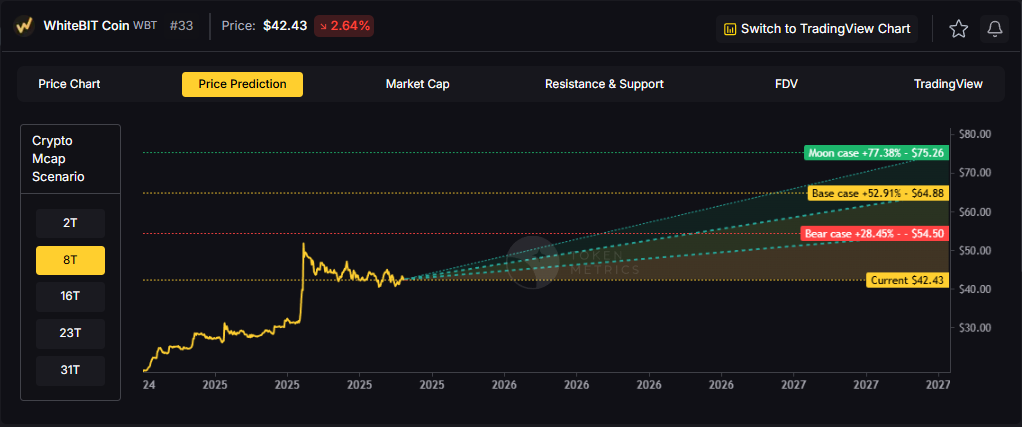
16T Market Cap Price Prediction:
Doubling the market to 16 trillion expands the price prediction range to $78.61 (bear), $109.75 (base), and $140.89 (moon).
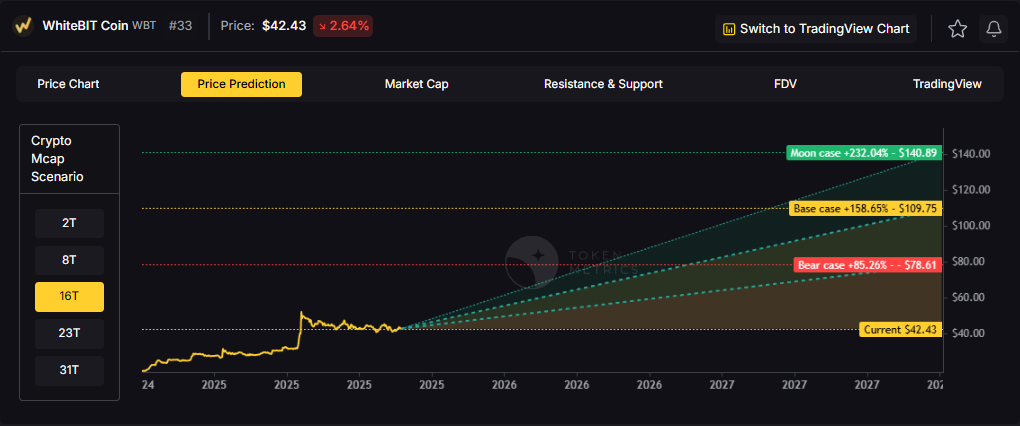
23T Market Cap Price Prediction:
At 23 trillion, the price forecast scenarios show $102.71, $154.61, and $206.51 respectively.
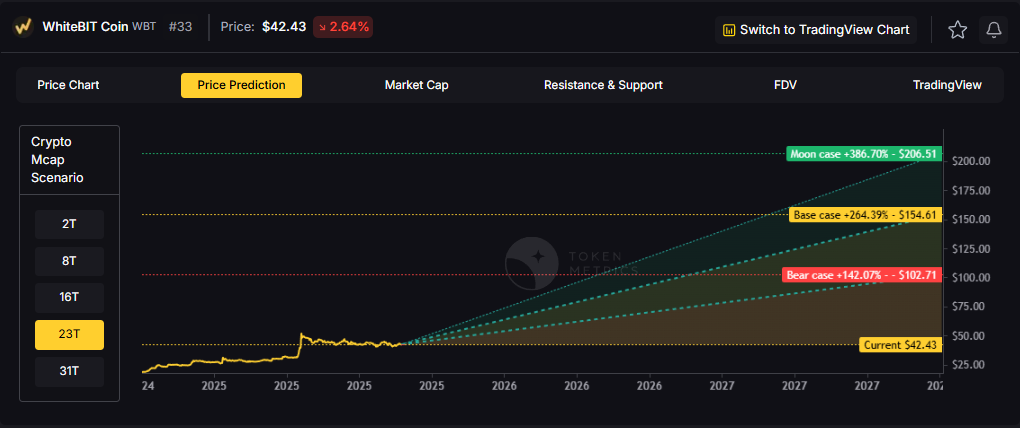
31T Market Cap Price Prediction:
In the maximum liquidity scenario of 31 trillion, WBT price prediction could reach $126.81 (bear), $199.47 (base), or $272.13 (moon).

These price prediction ranges illustrate potential outcomes for concentrated WBT positions, but investors should weigh whether single-asset exposure matches their risk tolerance or whether diversified strategies better suit their objectives.
What Is WhiteBIT Coin?
WhiteBIT Coin is the native exchange token associated with the WhiteBIT ecosystem. It is designed to support utility on the platform and related services.
WBT typically provides fee discounts and ecosystem benefits where supported. Usage depends on exchange activity and partner integrations.
Token Metrics AI Analysis for Price Prediction
Token Metrics AI provides comprehensive context on WhiteBIT Coin's positioning and challenges that inform our price prediction models.
Vision: The stated vision for WhiteBIT Coin centers on enhancing user experience within the WhiteBIT exchange ecosystem by providing tangible benefits such as reduced trading fees, access to exclusive features, and participation in platform governance or rewards programs. It aims to strengthen user loyalty and engagement by aligning token holders' interests with the exchange's long-term success. While not positioned as a decentralized protocol token, its vision reflects a broader trend of exchanges leveraging tokens to build sustainable, incentivized communities.
Problem: Centralized exchanges often face challenges in retaining active users and differentiating themselves in a competitive market. Users may be deterred by high trading fees, limited reward mechanisms, or lack of influence over platform developments. WhiteBIT Coin aims to address these frictions by introducing a native incentive layer that rewards participation, encourages platform loyalty, and offers cost-saving benefits. This model seeks to improve user engagement and create a more dynamic trading environment on the WhiteBIT platform.
Solution: WhiteBIT Coin serves as a utility token within the WhiteBIT exchange, offering users reduced trading fees, staking opportunities, and access to special events such as token sales or airdrops. It functions as an economic lever to incentivize platform activity and user retention. While specific governance features are not widely documented, such tokens often enable voting on platform upgrades or listing decisions. The solution relies on integrating the token deeply into the exchange's operational model to ensure consistent demand and utility for holders.
Market Analysis: Exchange tokens like WhiteBIT Coin operate in a competitive landscape led by established players such as Binance Coin (BNB) and KuCoin Token (KCS). While BNB benefits from a vast ecosystem including a launchpad, decentralized exchange, and payment network, WBT focuses on utility within its native exchange. Adoption drivers include the exchange's trading volume, security track record, and the attractiveness of fee discounts and staking yields. Key risks involve regulatory pressure on centralized exchanges and competition from other exchange tokens that offer similar benefits.
Fundamental Snapshot from Token Metrics
Fundamental Grade: 52.35% (Community 82%, Tokenomics 60%, Exchange 50%, VC —, DeFi Scanner N/A).
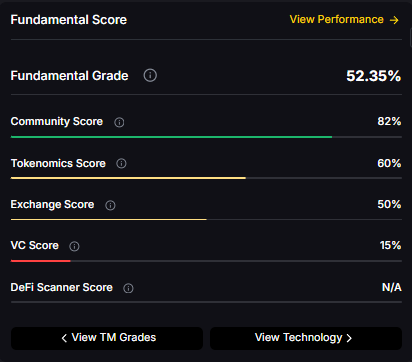
Catalysts That Skew Bullish for Price Prediction
- Institutional and retail access expands with ETFs, listings, and integrations
- Macro tailwinds from lower real rates and improving liquidity
- Product or roadmap milestones such as upgrades, scaling, or partnerships
- These factors could push WBT toward higher price prediction targets
Risks That Skew Bearish for Price Prediction
- Macro risk-off from tightening or liquidity shocks
- Regulatory actions or infrastructure outages
- Concentration in validator economics and competitive displacement
- Protocol-specific execution risk and competitive pressure from alternatives
- These factors could push WBT toward lower price prediction scenarios
FAQs: WhiteBIT Coin Price Prediction
Can WBT reach $100 according to price predictions?
Based on the price prediction scenarios, WBT could reach $100 in the 16T base case. The 16T tier projects $109.75 in the base case price forecast. Achieving this price prediction requires both broad market cap expansion and WhiteBIT Coin maintaining competitive position. Not financial advice.
What's the risk/reward profile for WBT price prediction?
Risk and reward in our price prediction model span from $54.50 in the lowest bear case to $272.13 in the highest moon case. Downside risks include regulatory actions and competitive displacement, while upside drivers include expanding access and favorable macro liquidity. Concentrated positions amplify both tails, while diversified strategies smooth outcomes.
What gives WBT value and impacts price predictions?
WBT accrues value through fee discounts, staking rewards, access to special events, and potential participation in platform programs. Demand drivers include exchange activity, user growth, and security reputation. While these fundamentals matter for price predictions, diversified portfolios capture value accrual across multiple tokens rather than betting on one protocol's success.
What is the 2028 WhiteBIT Coin price prediction?
Based on Token Metrics analysis, the 2028 price prediction for WhiteBIT Coin centers around $40 in the base case under current market conditions, with a range between $10 and $85 depending on market scenarios. Bullish price predictions range from $64.88 to $272.13 across different total crypto market cap environments.
Can WBT reach $200 by 2028?
According to our price prediction models, WBT could reach $200 in the 23T moon case ($206.51) and in the 31T scenarios where the base case is $199.47 and the moon case is $272.13. These price prediction outcomes require significant crypto market expansion and WhiteBIT maintaining strong competitive positioning. Not financial advice.
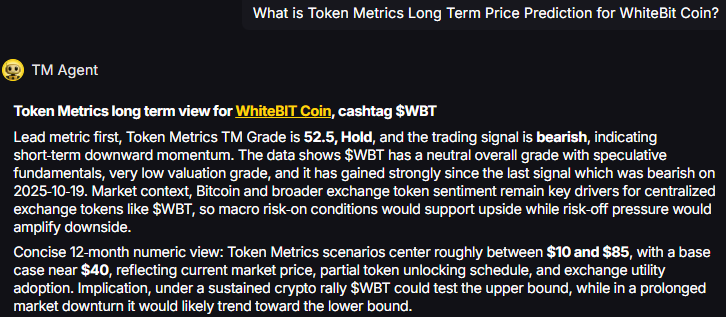
Next Steps
- Explore diversified crypto exposure: Token Metrics Indices Early Access
- Track WhiteBIT Coin fundamentals: Token Details
- Access Token Metrics platform for portfolio analytics
Disclosure
Educational purposes only, not financial advice. Crypto is volatile, concentration amplifies risk, and diversification is a fundamental principle of prudent portfolio construction. Do your own research and manage risk appropriately.
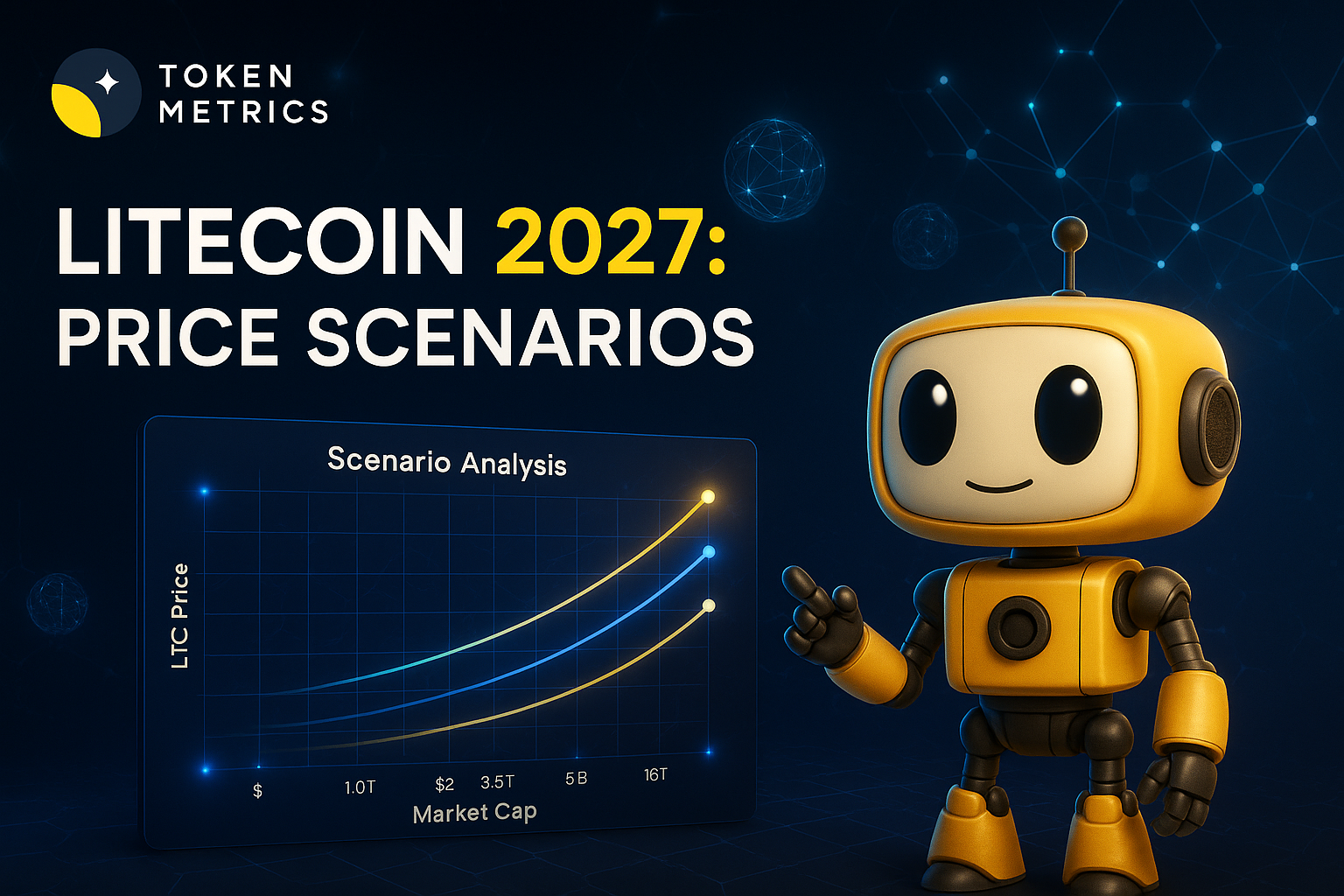
Predicting Litecoin Price in 2027: Scenario Analysis & On-Chain Scores
%201.svg)
%201.svg)
Litecoin Price Prediction Framework: Market Cap Scenarios & 2027 Forecast
Layer 1 tokens capture value through transaction fees and miner economics. Litecoin processes blocks every 2.5 minutes using Proof of Work, targeting fast, low-cost payments. The price prediction scenarios below model LTC outcomes across different total crypto market sizes, reflecting network adoption and transaction volume.

Disclosure
Educational purposes only, not financial advice. Crypto is volatile, do your own research and manage risk.
How to read this price prediction:
Each band blends cycle analogues and market-cap share math with TA guardrails. Base assumes steady adoption and neutral or positive macro. Moon layers in a liquidity boom. Bear assumes muted flows and tighter liquidity.
TM Agent baseline:
Token Metrics price prediction scenarios center roughly between $35 and $160, with a base case price target near $75, assuming gradual adoption, occasional retail rotation into major alts, and no major network issues. In a broad crypto rally LTC could test the upper bound price prediction, while in risk-off conditions it would likely drift toward the lower bound.
Key Takeaways for LTC Price Prediction
- Scenario driven: price prediction outcomes hinge on total crypto market cap; higher liquidity and adoption lift the price bands
- Fundamentals: Fundamental Grade 83.98% (Community 79%, Tokenomics 100%, Exchange 100%, VC —, DeFi Scanner 57%)
- Technology: Technology Grade 46.67% (Activity 51%, Repository 72%, Collaboration 60%, Security 20%, DeFi Scanner 57%)
- TM Agent gist: the TM Grade is 21.8 (Sell), and the trading signal is bearish, indicating short-term downward momentum
- Education only, not financial advice
Litecoin Price Prediction: Scenario Analysis
Token Metrics price prediction scenarios span four market cap tiers reflecting different crypto market maturity levels:
8T Market Cap Price Prediction:
At an 8 trillion dollar total crypto market cap, LTC price prediction projects to $115.80 in bear conditions, $137.79 in the base case, and $159.79 in bullish scenarios.
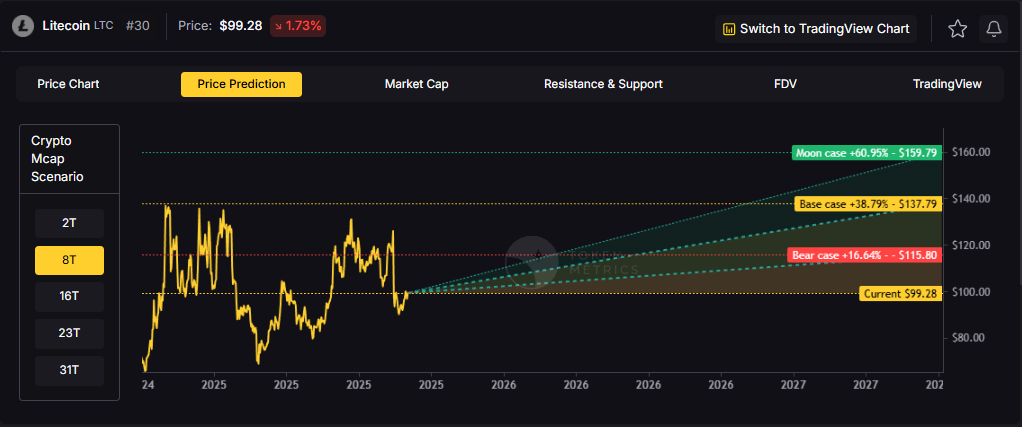
16T Market Cap Price Prediction:
At 16 trillion, the price prediction range expands to $154.54 (bear), $220.52 (base), and $286.50 (moon).
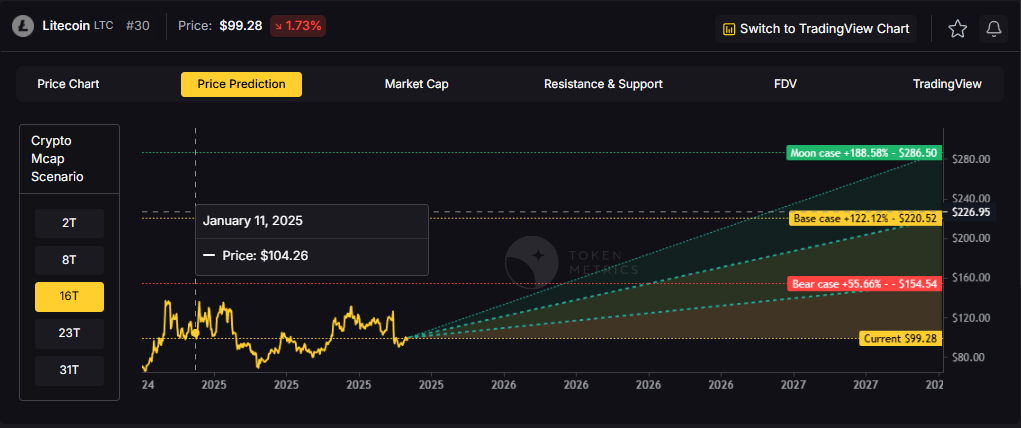
23T Market Cap Price Prediction:
The 23 trillion tier price forecast shows $193.28, $303.25, and $413.21 respectively.
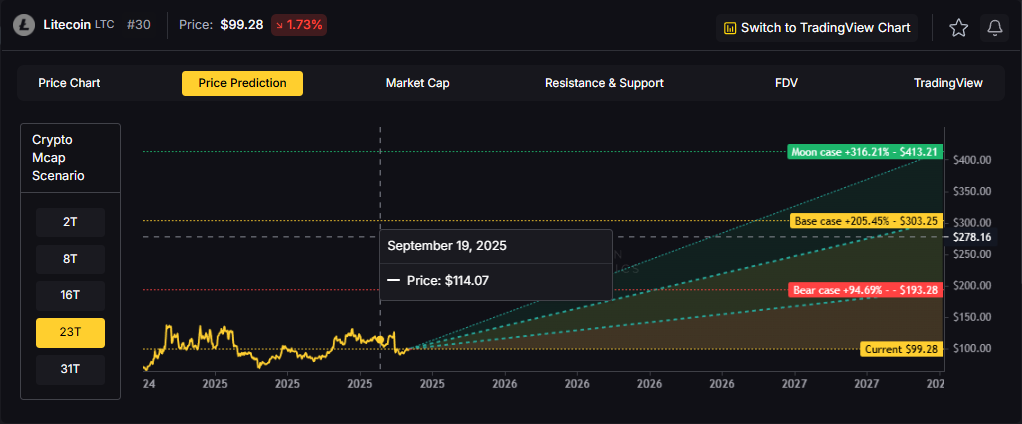
31T Market Cap Price Prediction:
In the maximum liquidity scenario at 31 trillion, LTC price prediction reaches $232.03 (bear), $385.98 (base), or $539.92 (moon).

What Is Litecoin?
Litecoin is a peer-to-peer cryptocurrency launched in 2011 as an early Bitcoin fork. It uses Proof of Work with Scrypt and targets faster settlement, processing blocks roughly every 2.5 minutes with low fees.
LTC is the native token used for transaction fees and miner rewards. Its primary utilities are fast, low-cost payments and serving as a testing ground for Bitcoin-adjacent upgrades, with adoption in retail payments, remittances, and exchange trading pairs.
Token Metrics AI Analysis for Price Prediction
Token Metrics AI provides additional context on Litecoin's technical positioning and market dynamics that inform our price prediction models.
Vision: Litecoin's vision is to serve as a fast, low-cost, and accessible digital currency for everyday transactions. It aims to complement Bitcoin by offering quicker settlement times and a more efficient payment system for smaller, frequent transfers.
Problem: Bitcoin's relatively slow block times and rising transaction fees during peak usage make it less ideal for small, frequent payments. This creates a need for a cryptocurrency that maintains security and decentralization while enabling faster and cheaper transactions suitable for daily use.
Solution: Litecoin addresses this by using a 2.5-minute block time and the Scrypt algorithm, which initially allowed broader participation in mining and faster transaction processing. It functions primarily as a payment-focused blockchain, supporting peer-to-peer transfers with low fees and high reliability, without the complexity of smart contract functionality.
Market Analysis: Litecoin operates in the digital payments segment of the cryptocurrency market, often compared to Bitcoin but positioned as a more efficient medium of exchange. While it lacks the smart contract capabilities of platforms like Ethereum or Solana, its simplicity, long-standing network security, and brand recognition give it a stable niche. It competes indirectly with other payment-focused cryptocurrencies like Bitcoin Cash and Dogecoin. Adoption is sustained by its integration across major exchanges and payment services, but growth is limited by the broader shift toward ecosystems offering decentralized applications.
Fundamental and Technology Snapshot from Token Metrics
Fundamental Grade: 83.98% (Community 79%, Tokenomics 100%, Exchange 100%, VC —, DeFi Scanner 57%).
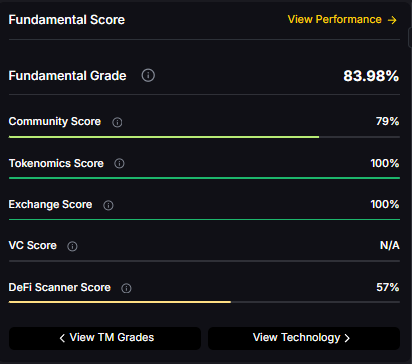
Technology Grade: 46.67% (Activity 51%, Repository 72%, Collaboration 60%, Security 20%, DeFi Scanner 57%).

Catalysts That Skew Bullish for Price Prediction
- Institutional and retail access expands with ETFs, listings, and integrations
- Macro tailwinds from lower real rates and improving liquidity
- Product or roadmap milestones such as upgrades, scaling, or partnerships
- These factors could push LTC toward higher price prediction targets
Risks That Skew Bearish for Price Prediction
- Macro risk-off from tightening or liquidity shocks
- Regulatory actions or infrastructure outages
- Concentration in validator economics and competitive displacement
- These factors could push LTC toward lower price prediction scenarios
Where to get deeper research and insights?
For comprehensive Litecoin ratings, on-chain analysis, AI-powered price forecasts, and trading signals, go to Token Metrics.
FAQs: Litecoin Price Prediction
What is LTC used for?
Primary use cases include fast peer-to-peer payments, low-cost remittances, and exchange settlement/liquidity pairs. LTC holders primarily pay transaction fees and support miner incentives. Adoption depends on active addresses and payment integrations, which directly impact long-term price prediction models.
What price could LTC reach in the moon case price prediction?
Moon case price predictions range from $159.79 at 8T to $539.92 at 31T total crypto market cap. These price prediction scenarios require maximum market cap expansion and strong adoption dynamics. Not financial advice.
What is the 2027 Litecoin price prediction?
Based on Token Metrics analysis, the 2027 price prediction for Litecoin centers around $75 in the base case under current market conditions, with a range between $35 and $160 depending on market scenarios. Bullish price predictions range from $137.79 to $539.92 across different total crypto market cap environments.
Can LTC reach $500 according to price predictions?
According to our price prediction models, LTC could reach $500+ in the 31T moon case where it projects to $539.92. This price prediction outcome requires significant crypto market expansion (31 trillion total market cap) combined with strong Litecoin network adoption. Not financial advice.
How does Litecoin's price prediction compare to Bitcoin?
While Litecoin was designed as "silver to Bitcoin's gold," its price prediction typically reflects a fraction of Bitcoin's value due to lower market cap and adoption. However, LTC often benefits from Bitcoin rallies while offering faster transaction times, which can impact relative price performance during payment-focused adoption cycles.

Next Steps
• Track live grades and signals: Token Details
Disclosure
Educational purposes only, not financial advice. Crypto is volatile, do your own research and manage risk.

Token Metrics Indices vs. Every Other Crypto Investment Option: The Complete Comparison
%201.svg)
%201.svg)
Cryptocurrency investors face overwhelming choices. Should you buy individual tokens, trade actively, stake for yield, use DeFi protocols, invest through funds, or use index strategies? Each approach promises wealth creation, but which actually delivers optimal risk-adjusted returns for typical investors?
Most comparison content presents biased perspectives promoting specific approaches. Crypto trading platforms emphasize active trading. DeFi protocols highlight yield farming. Fund managers promote their offerings. What's missing is objective, comprehensive analysis examining all options fairly.
This definitive comparison evaluates Token Metrics indices against every major crypto investment alternative. We'll examine advantages, disadvantages, costs, risks, and ideal investor profiles for each approach. By the end, you'll understand exactly why indices represent optimal choice for most investors—and when alternative approaches might make sense.
The Eight Major Crypto Investment Approaches
Before diving into detailed comparisons, let's categorize the landscape of crypto investment options available today.
- Individual Token Selection: Researching and buying specific cryptocurrencies directly
- Active Trading: Frequent buying and selling attempting to profit from price movements
- Staking and Yield Farming: Locking tokens in protocols to earn yields
- DeFi Protocol Participation: Providing liquidity or engaging in decentralized finance
- Crypto Hedge Funds: Investing through professionally managed funds
- Bitcoin-Only Strategy: Exclusively holding Bitcoin as digital gold
- Crypto ETFs/Trusts: Investing through regulated traditional financial products
- AI-Powered Index Strategies: Token Metrics systematic, diversified approach
Each serves different purposes and suits different investor types. Let's examine each comprehensively.
Individual Token Selection: The DIY Approach
Many investors begin by researching and selecting specific cryptocurrencies they believe will outperform.
- Advantages: Complete control over decisions without management fees. Potential for exceptional 100x+ returns from identifying winners early. Deep learning experience building genuine crypto understanding.
- Disadvantages: Proper research demands 10-20 hours weekly. Over 90% of projects fail within three years, risking total loss. Emotional decisions lead to buying high and selling low. Concentrated portfolios suffer catastrophic single-token failures. Constant monitoring creates anxiety and stress.
Ideal For: Full-time researchers with substantial time, emotional discipline through volatility, and ability to absorb total losses.
Token Metrics Comparison: Indices provide similar upside through diversification while eliminating research burden, reducing failure risk, and removing emotional decisions. For 95% of investors, indices deliver better risk-adjusted returns with 90% less time investment.
Active Trading: The Full-Time Job Approach
Some investors attempt profiting from short-term price movements through frequent trading.
- Advantages: Potential for quick gains in days/weeks rather than years. Leveraged trading amplifies profits. Constant market engagement provides excitement. Flexibility to adapt quickly to changing conditions.
- Disadvantages: Studies show 85-95% of traders lose money over time. Requires 40-80 hours weekly monitoring markets. Extreme stress causes burnout and poor life quality. Generates short-term capital gains taxed up to 37%. Trading fees, spreads, and slippage compound into 60%+ annually with frequent trades.
Ideal For: Professional traders with full-time career commitment, exceptional emotional discipline, acceptance of high failure probability, and substantial loss capital buffer.
Token Metrics Comparison: Indices capture market upside without trading's massive time requirements, emotional toll, tax inefficiency, or statistical disadvantages. Buy-and-hold index strategies outperform 90%+ of active traders after fees, taxes, and opportunity costs.
Staking and Yield Farming: The Income-Focused Approach
Staking tokens or providing liquidity generates yields—typically 5-20% APY depending on protocol and risk level.
Advantages- Passive Income Generation: Regular yield payments provide income stream separate from price appreciation, appealing to income-focused investors.
- Compounding Opportunities: Reinvesting yields creates compound growth acceleration similar to dividend reinvestment in traditional investing.
- Network Participation: Staking contributes to blockchain security and governance, providing purpose beyond profit seeking.
- Token Price Risk Dominates Yield: 15% APY means nothing if token price declines 60%—you're net negative despite yield
- Lock-Up Periods: Many staking arrangements lock tokens for weeks or months, preventing selling during crashes
- Impermanent Loss: Liquidity provision creates impermanent loss risk—you may have less value than simply holding tokens
- Protocol Risks: Smart contract bugs, exploits, or failures can eliminate entire positions despite careful selection
- Complexity Management: Moving between protocols chasing optimal yields requires constant attention and decision-making
- Tax Complications: Yield payments trigger ordinary income taxes potentially at high rates, and tracking cost basis across protocols proves complex
Yield strategies suit technically sophisticated investors comfortable evaluating smart contract risks, accepting token price volatility, having detailed tax tracking systems, and not needing access to capital during lock-up periods.
Token Metrics Indices ComparisonWhile staking provides 5-20% yields, Token Metrics indices typically generate 30-60% annualized appreciation through systematic selection and rebalancing. The appreciation far exceeds staking yields while maintaining liquidity, avoiding protocol risks, and simplifying tax treatment. Indices can incorporate staking where appropriate without requiring you to manage complexity.
DeFi Protocol Participation: The Sophisticated Approach
Decentralized finance protocols enable lending, borrowing, trading, and complex financial strategies without intermediaries.
Advantages- High Yield Potential: DeFi protocols sometimes offer exceptional yields—30-100%+ APY during periods of high demand and limited supply.
- Financial Innovation Access: DeFi enables strategies impossible in traditional finance—flash loans, automated market making, complex derivatives without counterparty risk.
- Transparency: All transactions occur on-chain providing complete visibility into protocol mechanics, reserves, and risks.
- Extreme Complexity: Understanding DeFi protocols requires technical knowledge of smart contracts, liquidity pools, tokenomics, and blockchain mechanics
- Smart Contract Risks: Bugs, exploits, or economic attacks can drain funds despite audits—DeFi history includes billions lost to exploits
- Gas Fee Costs: Ethereum gas fees make small position management uneconomical—often paying $50-200 per transaction during high network usage
- Yield Volatility: DeFi yields fluctuate dramatically—100% APY quickly becomes 10% APY requiring constant position adjustment
- Regulatory Uncertainty: DeFi exists in regulatory gray area potentially facing restrictions limiting future participation
- Overwhelming Options: Hundreds of protocols create analysis paralysis and risk of choosing unstable or dishonest platforms
DeFi suits technically expert investors who understand smart contracts deeply, actively manage positions across protocols, accept total loss risk from exploits, and have capital sufficient to absorb gas fees.
Token Metrics Indices ComparisonIndices provide professional crypto exposure without DeFi's complexity, smart contract risks, gas fee burdens, or technical expertise requirements. For investors seeking crypto appreciation without becoming blockchain developers, indices deliver far superior risk-adjusted returns.
Crypto Hedge Funds: The Institutional Approach
Some investors access crypto through professionally managed hedge funds specializing in digital assets.
Advantages- Professional Management: Experienced portfolio managers make investment decisions leveraging institutional research and resources.
- Access to Complex Strategies: Funds employ sophisticated strategies beyond typical retail investor capabilities—arbitrage, options, private placements.
- Risk Management: Institutional risk management frameworks and processes potentially reduce volatility and limit losses.
- Extremely High Fees: Traditional "2 and 20" structure charges 2% annually plus 20% of profits—these fees compound into enormous costs over time
- High Minimums: Most crypto hedge funds require $100,000-1,000,000 minimum investments, excluding typical investors
- Limited Liquidity: Quarterly or annual redemption windows prevent accessing capital when needed
- Manager Risk: Performance depends entirely on specific manager's skill—past performance doesn't guarantee future results
- Lack of Transparency: Many funds don't disclose holdings or strategies, creating uncertainty about actual exposures
- Mediocre Performance: Most crypto hedge funds underperform simple buy-and-hold strategies after accounting for fees
Crypto hedge funds suit ultra-high net worth investors ($5M+ portfolios) seeking professional management, comfortable with illiquidity, and willing to pay premium fees for institutional infrastructure.
Token Metrics Indices ComparisonToken Metrics provides institutional-grade AI management at fraction of hedge fund costs—$50-200 monthly subscription versus $10,000+ annually in hedge fund fees for typical portfolio sizes. Performance is transparent, capital remains liquid, and minimums are under $1,000 versus six-figure hedge fund requirements.
Bitcoin-Only Strategy: The Minimalist Approach
Some investors exclusively hold Bitcoin, viewing it as digital gold.
- Advantages: Simple single-asset strategy eliminates research complexity. Fifteen-year track record demonstrates survival through multiple cycles. Most mature security practices and custody solutions. Limited supply supports store-of-value thesis.
- Disadvantages: Other cryptocurrencies often outperform Bitcoin during bull markets. Single asset means Bitcoin-specific issues harm entire portfolio. Limited growth potential—100x returns unlikely given size. No diversification or rebalancing benefits.
Ideal For: Conservative investors prioritizing simplicity and security over maximum returns, or those philosophically committed to Bitcoin specifically.
Token Metrics Comparison: Conservative indices typically hold 40-60% Bitcoin while adding diversified exposure to other quality projects. This provides Bitcoin's stability while capturing additional upside from emerging winners—historical data shows 30-50% higher returns than Bitcoin-only with similar volatility.
Crypto ETFs and Trusts: The Traditional Finance Approach
Recently approved Bitcoin ETFs and existing crypto trusts provide regulated exposure through traditional brokerage accounts.
Advantages- Regulatory Compliance: SEC-approved products provide legal certainty and investor protections unavailable with direct crypto holdings.
- Brokerage Integration: Hold crypto exposure alongside stocks and bonds in existing retirement accounts and brokerage accounts.
- Simplified Custody: No need for wallets, private keys, or exchange accounts—all handled by fund custodian.
- Tax Reporting Integration: Broker-provided 1099 forms simplify tax filing versus tracking individual crypto transactions.
- Management Fees: ETFs charge 0.2-2.5% annually reducing returns—these fees compound substantially over decades
- Limited Options: Currently only Bitcoin ETFs approved—no Ethereum or diversified crypto ETFs available broadly
- Premium/Discount Volatility: Some trusts trade at premiums or discounts to net asset value creating tracking errors
- No Token Ownership: You own fund shares, not actual crypto—can't stake, participate in governance, or use tokens in DeFi
- Counterparty Risk: Depend on fund operator solvency and custody practices rather than controlling assets directly
Crypto ETFs suit traditional investors prioritizing regulatory comfort, wanting retirement account exposure, avoiding direct crypto custody, and accepting limited options for that convenience.
Token Metrics Indices ComparisonToken Metrics offers far broader diversification than current ETFs (Bitcoin only), typically lower costs, direct asset ownership providing full flexibility, and exposure to full crypto opportunity set rather than single asset. For investors comfortable with direct crypto custody, indices provide superior returns and options.
Token Metrics AI-Powered Indices: The Optimal Balance
After examining alternatives, let's detail Token Metrics indices comprehensive advantages.
Unique Advantages- Professional AI Management Without Hedge Fund Costs: Institutional-grade algorithms at $50-200 monthly versus $10,000+ hedge fund fees
- Diversification Without Research Burden: Exposure to 20-50 quality tokens without spending hundreds of hours researching each
- Systematic Rebalancing: AI-driven rebalancing captures profits from winners and accumulates losers at discounts automatically
- Emotional Decision Elimination: Predetermined rules prevent fear and greed-driven mistakes that destroy returns
- Tax Optimization Opportunities: Strategic loss harvesting and holding period management minimize tax burden
- Flexibility Across Risk Profiles: Conservative to aggressive indices suit different investor needs within single platform
- Complete Liquidity: Exit positions any time unlike hedge funds, locked staking, or illiquid investments
- Transparent Performance: Track record visible rather than opaque fund reporting
For Whom Indices Work Best
Token Metrics indices suit 95% of crypto investors—those wanting professional exposure without full-time trading careers, seeking diversification without research burden, prioritizing long-term wealth building over short-term speculation, and valuing systematic approaches over emotional decision-making.
Conclusion: Why Indices Win for Most Investors
This comprehensive comparison reveals consistent pattern: alternative approaches offer niche advantages for specific situations but indices provide optimal balance of return potential, risk management, time efficiency, and cost effectiveness for typical investors.
Individual selection works if you're full-time researcher. Active trading works if you're professional trader. DeFi works if you're blockchain developer. Hedge funds work if you have millions. ETFs work if you want only Bitcoin in retirement accounts.
But if you're typical investor—employed professional, business owner, or retiree wanting substantial crypto exposure without it becoming second job—Token Metrics indices deliver superior risk-adjusted returns with minimal time investment and emotional burden.
The proof isn't theoretical—it's mathematical. Systematic, diversified, professionally managed approaches outperform alternatives across decades of investment research in every asset class. Crypto's unique characteristics amplify these advantages rather than diminishing them.
Your choice is clear: spend hundreds of hours researching individual tokens, stress over active trading, manage DeFi complexity, pay excessive hedge fund fees, or achieve superior results through systematic index investing requiring minimal time and expertise.
Start your 7-day free trial today and discover why sophisticated investors increasingly choose Token Metrics indices over every alternative approach.


Get Your Brand in Front of 150,000+ Crypto Investors!




 Create Your Free Account
Create Your Free Account9450 SW Gemini Dr
PMB 59348
Beaverton, Oregon 97008-7105 US
.svg)
No Credit Card Required


Online Payment


SSL Encrypted
.png)
Products
Subscribe to Newsletter
Token Metrics Media LLC is a regular publication of information, analysis, and commentary focused especially on blockchain technology and business, cryptocurrency, blockchain-based tokens, market trends, and trading strategies.
Token Metrics Media LLC does not provide individually tailored investment advice and does not take a subscriber’s or anyone’s personal circumstances into consideration when discussing investments; nor is Token Metrics Advisers LLC registered as an investment adviser or broker-dealer in any jurisdiction.
Information contained herein is not an offer or solicitation to buy, hold, or sell any security. The Token Metrics team has advised and invested in many blockchain companies. A complete list of their advisory roles and current holdings can be viewed here: https://tokenmetrics.com/disclosures.html/
Token Metrics Media LLC relies on information from various sources believed to be reliable, including clients and third parties, but cannot guarantee the accuracy and completeness of that information. Additionally, Token Metrics Media LLC does not provide tax advice, and investors are encouraged to consult with their personal tax advisors.
All investing involves risk, including the possible loss of money you invest, and past performance does not guarantee future performance. Ratings and price predictions are provided for informational and illustrative purposes, and may not reflect actual future performance.



%201.svg)

